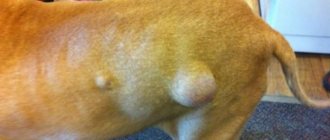For a dog owner encountering seizures in a dog for the first time, this sight comes as a real shock. However, you must try to pull yourself together, calm down and help your pet, who at the moment really needs it.
Let's look at the reasons why seizures occur in dogs and how you can help your pet.
Types of seizures
Seizures in dogs are divided into four types.
- Convulsions are small, jerky muscle spasms. The animal is able to remain on its feet, does not lose consciousness, and responds to commands. Externally, convulsions look like twitching and may not immediately attract the owner’s attention.
- Tonic convulsions - veterinarians consider their manifestation not too serious a threat, since these are short-term muscle contractions. However, the pet is in pain. During tonic spasms, the dog is conscious and what is happening frightens it. She may whine and become confused in a familiar, homely environment. It is easy to identify this species externally thanks to slow twitching at the same time interval.
- Clonic convulsions - a distinctive feature is a long period of time. This is a seizure in which dogs experience repeated bouts of convulsions once every 30 seconds to two minutes. The spasm goes away and the dog tries to get up, but soon a new wave of the attack makes him fall again. The animal is in pain. It is difficult to react to an unexpected condition.
- Epileptic seizure - from the name it is clear that this type of illness is dangerous and severe. It is characterized by: complete loss of consciousness, tension and constant muscle contraction. The animal's eyes are often closed, but an attack is possible with open eyes without signs of reaction. The dog is in pain. After a seizure, he does not recover immediately. The gait will be unsteady and swaying. The state is sluggish.
Diagnostics
Firstly, the most detailed medical history is necessary (ideally, starting from puppyhood). A thorough examination of the animal is also necessary; an MRI and an encephalogram are highly desirable (in general, this is the only chance to identify pathologies and brain damage).
Alas, there are simply no specific tests to detect epilepsy. What information can the owner provide to help the veterinarian make a diagnosis? Everything he can remember:
- Do seizures develop during sleep or wakefulness?
- How long does each attack last and how often do they occur?
- Are there any symptoms similar to those of infectious diseases?
- Has your dog's body temperature increased recently?
- Has your pet been treated for serious poisoning?
- Was it after childbirth that strange things began (perhaps it was eclampsia)?
- Has the dog been in contact with any “strange” animals recently?
- How often do you walk your dog, and where exactly do you do it?
- What exactly do you feed your pet?
- Does the dog have all the necessary vaccinations, has it been treated for worms?
- Has your dog had any behavioral changes?
- Is there a relationship between walking, eating, environmental conditions (loud sounds, smells) and the onset of an attack?
- Were there any episodes of surgical interventions? Didn't the seizures start after the operation?
- Does your dog remain conscious during a seizure?
Causes
Seizures in dogs have reasonable causes. This is a visible manifestation of the disease. Only a qualified veterinarian can establish a connection between muscle spasms and disease, but every owner should be aware of diseases with such manifestations.
- Eclampsia. The disease occurs due to a lack of calcium in the body. Animals of small breeds weighing up to 5 kg are most often affected. Pregnant and lactating bitches are especially susceptible. The result of a long-term lack of calcium in the blood is convulsions.
- Hypoglycemia and hyperglycemia - there is not enough glucose in the blood or there is an excess. Both are deviations from the norm that cause metabolic disorders. Kidneys and liver suffer. When neglected, it leads to serious damage to internal organs and the brain. The disease can be hereditary and acquired as a result of an improper diet.
- Intoxication of the body caused by any reason - poisoning, bites of poisonous animals, insects, advanced disease - is also the cause of seizures. One of them is hyperammonemia - dysfunction of the kidneys. The body poisons itself with untimely elimination of the breakdown products of substances.
- Injuries to the spine, head, internal organs.
- Infectious diseases are a common cause of uncontrolled convulsions. Dangerous to humans - rabies.
Epilepsy, as a cause of prolonged, painful seizures, deserves separate consideration. It occurs due to disturbances in the functioning of the brain due to a tumor, injury, inflammation, previous or untreated infectious disease, or heredity.
Epilepsy is in most cases a genetic disorder. Therefore, pets suffering from this disease are not recommended to reproduce. Next, there are acquired causes that affect the brain:
- Intoxication.
- Plague, toxoplasmosis, tetanus.
- Snake and insect bites.
- Helminths.
- Skull injuries.
- Malnutrition.
- Kidney diseases, cirrhosis.
- Diabetes.
- Hypovitaminosis.
- Mineral deficiency.
- Arrhythmia, brain cancer.
- Electric shock.
Often, due to inexperience, seizures are confused with a drunken gait of an animal, the cause of which is degenerative myelopathy. Rhythmic twitching during sleep is normal for puppies. And old dogs can tremble in their sleep and even whine. However, this is also a normal phenomenon and is completely different from painful cramps.
Who is at risk?
Seizures are most often observed in small breed dogs. This is explained by their tendency to low blood glucose levels, and, accordingly, to hypoglycemic attacks. Also, miniature individuals more often suffer from eclampsia - a sharp increase in blood pressure.
Males are more susceptible to seizures: males are much more prone to epilepsy and neurological disorders than females.
This disease is common in collies, dachshunds, poodles, Labradors, huskies, and boxers. These breeds are at increased risk of congenital or acquired epilepsy.
What to do
- You should not be afraid, scream, shake the animal and scare it even more with your reaction.
- At home, you need to move your pet to a familiar place, where there is no bright lighting, sharp corners and there is fresh air. If this happens during a walk, you need to cross the shade in the hot season, and in the cold season find bedding on the bare ground: collect leaves, tear off the cardboard, put your pet in the trunk of the car.
- Turn your pet on its right side, this makes breathing easier.
- There is no need to give your dog any medications, try to give him water to drink, or massage his muscles while the spasm continues.
- If a seizure occurs for the first time for unknown reasons, you should immediately consult a doctor. If unexpected spasms are an unpleasant reality that you have to live with and struggle with, then you should record the frequency and, when visiting a veterinarian, talk about the course of the disease.
- Given modern technology, it is good to ask someone or yourself to film the attack on your phone. Then it will be easier for the doctor to determine the symptoms of the disease.
First aid
It is difficult for an ignorant person to expect an attack or predict its approach, but it is possible to be prepared for such a situation. The duration of the seizure or its course cannot be influenced. The goal is to prevent more severe consequences.
- Record how long the spasms and other noticeable manifestations last. Observe which muscles cramp the most: the front legs, the hind legs or the whole body.
- Try to prevent the dog from hitting objects, a wall, a tree, or falling down the stairs.
- Place your pet on the bedding.
- At the end of the seizure, gently stroke and offer water. You should not feed yet.
- Support your dog emotionally with care. She is confused and does not understand why this is happening.
- If a pain attack does not end for more than 10 minutes or after completion the pet does not come to its senses for more than thirty minutes, you need to call an ambulance or go to the doctor yourself.
Life-threatening convulsive syndrome - epistatus. The attack lasts 5-7 minutes and is repeated at intervals of less than 30 minutes. Requires immediate assistance.
It is forbidden:
- stick out your tongue, try to open or close your mouth;
- leaving your pet alone;
- It is advisable that during and after a seizure the animal is not frightened by loud sounds or irritated by strong and pungent odors.
Course of a seizure
Typically, a seizure can be divided into several stages:
- The first stage, preceding the attack itself, is called an aura. At this time, the dog may drool excessively, become restless and begin to wander aimlessly. This condition can be observed in a dog from several minutes to several days, depending on the condition of the body.
- The most difficult stage is the blow, that is, the attack itself, accompanied by convulsions, the dog’s hind legs fail, and in some cases there is a strong flow of saliva and involuntary urination. This stage lasts for several minutes.
- After the attack, a post-traumatic stage begins, during which the animal becomes lost and disoriented. During this period, the dog may avoid the owner or, conversely, show excessive affection towards him, and profuse salivation may also continue. The duration of the post-traumatic stage varies, and it can end in minutes, or it can drag on for a day or two.
A single attack does not pose a particular danger to dogs, but frequently repeated seizures lasting for 10-15 minutes are a serious threat to the life and health of the animal.
Treatment
Only a doctor should prescribe medications and treatment. For a high-quality diagnosis, it is necessary to take blood and urine tests. Additional research will be required:
- Ultrasound; MRI; CT; ECHO;
- X-ray of the spine, skull;
- examination by a veterinarian-neurologist.
The priority and need for research is determined by the doctor.
Immediately, even before detailed tests, the veterinarian may prescribe intramuscular injections of magnesium sulfate. Thanks to the antihistamine effect of the drug, attacks will not recur in the near future. Then, more detailed treatment will follow. It is dangerous to administer the drug yourself.
The main reason why an animal cannot be cured is neglecting the veterinarian’s recommendations and stopping treatment on its own. It's a big mistake to rely on your own judgment. It may seem that everything is fine with your pet, there have been no seizures for a long time and it is enough to stuff him with medications. However, only a specialist can say with confidence that the disease has receded, after confirming a visual examination with additional studies. A methodical approach to treatment depends on the owner, and professional recommendations depend on the doctor.
Survey
As can be seen from the above, seizures are a symptom that can be caused by a huge number of diseases that affect both the brain itself and other body systems, therefore, to determine the underlying disease, it is necessary to conduct a thorough, consistent diagnosis.
First of all, a detailed history of the animal’s life and illness is important to the veterinarian; this plays a huge role in diagnosing pathologies of the nervous system. Differential diagnoses for seizures will depend on age, gender, breed, previous diseases, heredity, vaccination status, living conditions and feeding, and much more. It is important for the doctor to know at what age the dog began to have seizures, with what frequency they occur, whether the course of the seizures is progressing in severity and duration, whether there are any factors that provoke seizures, how exactly the seizure proceeds, whether the animal is conscious during it , how does one feel during the post-convulsive period and are there any problems during the periods between convulsions. If the owner can provide video of the pet's seizure, this will be a significant help to the doctor. After collecting anamnesis, the doctor will conduct a general clinical and neurological examination of the dog.
Most often, they first try to exclude extracranial causes of seizures, and then intracranial ones; only after excluding all these causes can a presumptive diagnosis of primary or idiopathic epilepsy be made.
First of all, a minimum set of studies is carried out, including general clinical and biochemical blood tests, urinalysis, blood glucose, and blood pressure. Depending on the results obtained, more specialized methods may be needed that are necessary to diagnose specific metabolic disorders, such as: blood ammonia, bile acid concentrations, hormone studies, tests for infections and others.
After excluding extracranial causes, they begin to exclude brain diseases; for this, magnetic resonance imaging (MRI) (Fig. 2) and examination of cerebrospinal fluid (CSF) are the methods of choice. Electroencephalography helps clarify the nature of the underlying disease and objectify the presence of convulsive activity. All these types of studies are carried out under sedation, so the results of blood tests and ultrasound of the heart will be required before them.
Rice. 2 MRI of the head of a dog with cluster seizures. T2-WI and T1-WI images with contrast. Arrows indicate a neoplasm of the right olfactory lobe and the right frontal lobe of the cerebral cortex with a cystic component and accompanying peritumoral edema.
When should you rush to the vet?
Can you notice the signs of an approaching attack? Yes. To do this, it is important to know what physiological parts a seizure consists of.
- The first phase is Aura. Over a short period of time or several days, the dog behaves restlessly: periodically trembles, increased salivation. Howls for no reason, hides or wanders aimlessly around the territory. These same signs are characteristic of other painful conditions. So it’s difficult to say one hundred percent that a seizure is approaching. However, if the owner knows about the possibility of an attack, then such factors will help decide on further actions.
- The second phase is Impact. Convulsions begin lasting several seconds or minutes. The dog falls and dodges. Saliva flows from the mouth. He might wet himself.
- The third phase is the post-traumatic period. Occurs immediately after impact. The pet is confused and disoriented. It may not respond to the owner or, conversely, cuddle and ask for protection. This period lasts up to several days.
You should rush to see a doctor:
- if the attack occurs more than twice during the day;
- if the duration of one seizure is more than 10 minutes;
- if the next seizure begins when the animal has not yet returned to normal after the previous one;
- if even before the attack there were alarming conditions: refusal of water, food, lethargy, vomiting, diarrhea, difficulty breathing;
- if the dog is chronically ill;
- if a puppy has a seizure.
Stages and symptoms of seizures in dogs
Owners, especially beginners, are not always able to recognize the initial stage of an approaching seizure. If this is not the first time that a dog has had seizures, it is easier to notice them and provide first aid. Typically an attack is divided into three stages:
- Aura
- the time when the approach of seizures is noticeable. The dog behaves restlessly, the limbs and tail begin to shake a little. The aura can be short-term - from a few minutes - or long-lasting. In some cases it takes 2-3 days.
- Main Impact
. Characterized by foaming at the mouth and seizures in the dog. The pet does not move its paws, falls, its mouth becomes covered with saliva or foam, and involuntary urination is acceptable.
- Post-traumatic stage
- the time when the seizure just ended. The animal is disoriented, absent-minded, whining from a headache. This continues from an hour to a day.
It is important to notice the onset of an attack at the initial stage - this way you will have more time to provide all possible assistance and protect you from unpleasant consequences. Record the time when the attack began and ended. You will then provide this information to your veterinarian.
Prevention
Veterinarians recommend preventive measures that do not guarantee, but reduce the likelihood of disease.
- Balanced diet; This measure looks like a general recommendation, but its importance does not diminish. Nutrient imbalances are always dangerous. In this case, you should pay attention to the amount of glucose and calcium in the pet’s body.
- Avoiding contact with household chemicals, as well as toxic substances that can easily be found on the street.
- Walking on a leash is recommended if the area is unfamiliar and not fenced; It is important to remember that if the dog becomes confused after an attack, it may run away.
- Regular scheduled vaccinations.
Which breeds are more susceptible to muscle spasms?
As noted above, in this article, small breeds are at risk : dwarf Spitz, Yorkshire terriers, Chihuahuas. The reasons are different. Premature birth and poor feeding guarantee an imbalance of glucose and calcium. Stressful situations and changes in the usual environment also affect the metabolism of these children. Miniature individuals have a weaker nervous system.
Of the large breeds, labradors, huskies, and collies are most often affected. From medium poodles and dachshunds. Here, more often than not, heredity plays a significant role.
Experienced breeders know that epilepsy can manifest itself in the early stages of development of babies, so it is possible to select puppies with manifestations of the disease. The first sign of which is convulsions.
conclusions
Cramps are not a disease, but only a symptom. Leaving this sign unattended is extremely dangerous. Hoping that this happened once and will not happen again is unreasonable. Starting self-treatment is fraught with aggravation of the disease. It is important to get more information about the possible causes of cramping and decide what to do next.
In addition to medical care, the little friend needs emotional rehabilitation. Lack of control over one's own body, pain, and loss of consciousness lead the already weak animal into a state of shock. Maximum care should be taken. Talk calmly, kindly. Praise and hug gently. And the main thing is to be nearby.
The owner must understand that seizures are a manifestation of the disease and not hope that this was a one-time incident. The dog needs help both urgently and permanently. If the attacks are ignored, the animal will suffer and die as a result. At some point, coexistence with people will become impossible due to the manifestation of an advanced disease. Then it will be too late to contact the veterinarian. Treatment requires timeliness.
Read more: How to stop epileptic seizures in dogs
Classification of epilepsy by type of seizure
- Generalized epileptic seizures. The condition that is commonly thought of when one hears of epilepsy. These are attacks in which the epileptic focus spreads to both hemispheres of the brain, respectively, the attacks are generalized, that is, they are observed on both sides of the body. Usually occurs with loss of consciousness. Convulsions that occur during generalized epileptic seizures are usually:
A. Tonic - short-term rigid muscle tension and extension of the limbs.
b. Clonic - uncoordinated, sudden, aimless movements of the limbs.
V. Tonic-clonic - a sequence of tonic and clonic phases, replacing each other.
d. Myoclonic - rhythmic movements of a body part (usually on both sides of the body) as a result of sudden involuntary muscle contraction, followed by relaxation.
There are also non-convulsive generalized epileptic seizures, which are called atonic; they represent a sharp loss of muscle tone, and the animal falls.
- Focal epileptic seizures. Seizures in which the epileptic focus is located in one hemisphere and the symptoms are local in nature. These can be motor, behavioral, autonomic disorders and manifest themselves both individually and together.
A. Motor disturbances: periodic focal motor phenomena (rhythmic jerking of the head or excessive blinking, repeated twitching of one limb, contractions of the facial muscles).
b. Autonomic disturbances: vomiting, dilated pupils, drooling, uncontrolled bowel movements or urination.
V. Behavioral disorders: episodic changes in the animal's behavior. A usually peaceful animal can become aggressive, or vice versa, animals can suddenly begin to hide or seek the proximity of the owner.
- Focal epileptic seizures turning into generalized ones. The case when seizures begin as focal ones, which are associated with the local spread of pathological epileptic activity of neurons in the brain, which subsequently spreads to both hemispheres. The clinical picture looks accordingly: first, behavioral, autonomic or motor disturbances, which are quickly replaced by generalized seizures.











